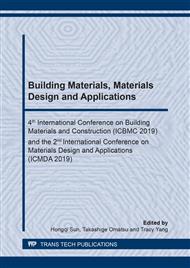p.134
p.141
p.148
p.159
p.165
p.172
p.178
p.185
p.191
A Study on the Effect of Argon-Oxygen Plasma Treatment on Ultra-Thin Expanded PTFE Membrane
Abstract:
Polymer films are plasma treated to improve surface properties making them hydrophilic or hydrophobic. Expanded polytetrafluoroethylene (ePTFE) is used in a wide variety of applications but only a few report on plasma treated ePTFE. Within these very few studies on ePTFE, the use of ultra-thin membrane could hardly be found. The purpose of this study is to investigate the effect of plasma treatment (Argon-Oxygen) on the hydrophobicity of ultra-thin ePTFE membrane (4um thickness). This study used nine (9) experimental legs of ePTFE subjected to respective plasma power (150W, 315W and 600W) and exposure time (300s, 450s and 600s) for each leg. Contact angle was measured prior and after subjecting to plasma condition using contact angle meter. Energy pen was also used to verify its hydrophobicity. Scanning electron microscopy (SEM) with 10,000x magnification was used to check for any change in surface after exposing to each condition. The findings showed that the membrane surface changed after exposure to plasma. All legs became hydrophilic. 102◦ contact angle was measured from raw sample, but the samples exposed to plasma had contact angles ranging from max of 68◦ to min of 48◦. The results showed that the degree of surface change could be correlated to the plasma parameters applied. Furthermore, the highest radio frequency (RF) power applied resulted to contact angle in the range of 60◦ while the lowest RF power applied resulted to the lowest contact angle, in the range of 40◦, measured. On the other hand, no particular trend was observed based on exposure time. Based on the gathered results, the ultra-thin ePTFE, in order to maintain its hydrophobicity, must not be applied with argon-oxygen plasma treatment. However, if the ultra-thin ePTFE is to be made hydrophilic, argon-oxygen plasma treatment could be applied while adjusting the plasma parameters to meet the desired hydrophilicity level.
Info:
Periodical:
Pages:
165-171
Citation:
Online since:
October 2019
Authors:
Price:
Сopyright:
© 2019 Trans Tech Publications Ltd. All Rights Reserved
Share:
Citation:


